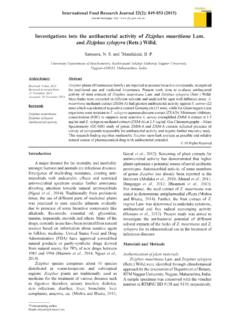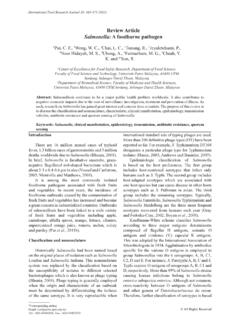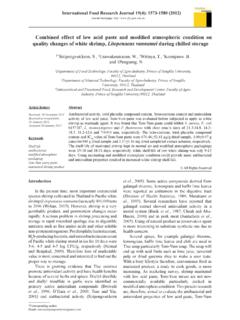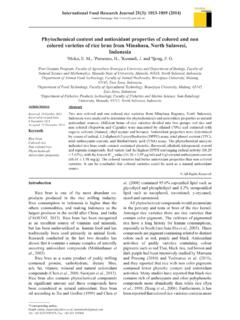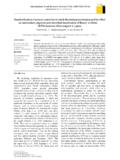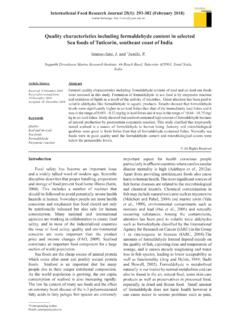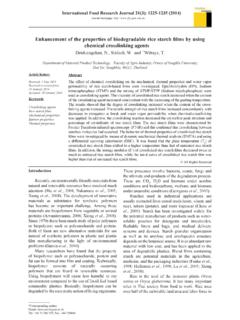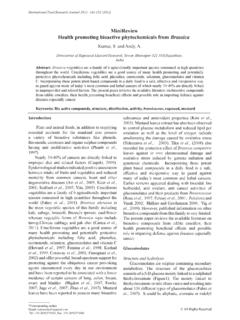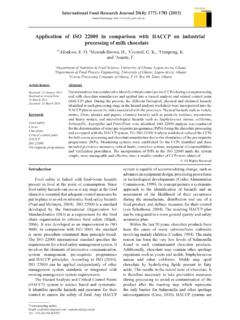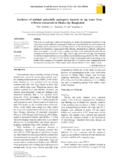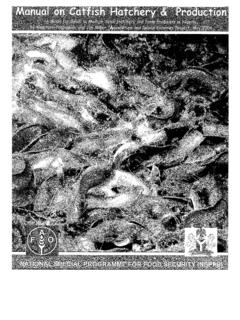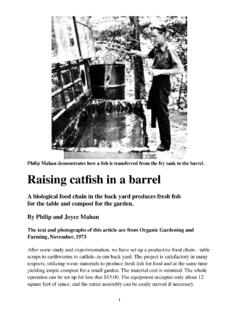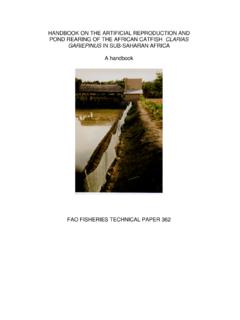Transcription of Physicochemical properties of silver catfish …
1 All Rights Reserved*Corresponding author. Email: +609 6683507; Fax: +609 6683434 International Food Research Journal 20(3): 1255-1262 (2013)Journal homepage: *Amiza, M. A., 1Ow, and 2 Faazaz, A. L. 1 Department of Food Science, Faculty of Agrotechnology and Food Science, Universiti Malaysia Terengganu, 21030 Kuala Terengganu, Terengganu. Malaysia2 Fishery Research Institute, Jalan Batu Maung 11960 Batu Maung, Penang, Malaysia Physicochemical properties of silver catfish (Pangasius sp.) frame hydrolysateAbstractThe Physicochemical properties of silver catfish frame hydrolysate powder at three different degree of hydrolysis, DH43%, DH 55% and DH 68% were studied.
2 The hydrolysates powder were obtained by hydrolysis using Alcalase , centrifugation and spray drying of the supernatant. The study found that preparation of these hydrolysates affected the protein, ash and fat content as well as amino acid composition. As for essential amino acids, their values were generally considered as adequate as compared to the suggested essential amino acids profile of FAO/WHO. The results showed that SFHs were rich in lysine and glutamate. Hydrolysate at DH 68% exhibited better peptide solubility and water holding capacity.
3 As degree of hydrolysis increased, emulsifying capacity and foaming capacity of the hydrolysate decreased. It was also found that the lightness in hydrolysate powder decreased with increase in degree of hydrolysis. This study shows that silver catfish frame hydrolysate has good solubility, good foaming properties and light colour profile, thus having high potential as food ingredient. IntroductionAmong the by-products from fish processing plants are fish frames which include bone, heads and tails. Bones constitute a significant part of the fish; approximately 10-15% of total fish biomass is bones from the head and vertebrae and contain considerable amount of proteins and minerals.
4 High protein content in fishery waste make them more perishable, may bring undesirable effects to environment pollution, as well as high cost in managing waste disposal. Production of fish protein hydrolysate via enzymatic hydrolysis is one way to add value to proteinaceous fish waste (Aspmo et al., 2005). Enzymatic modification of proteins using selected proteolytic enzyme preparations to cleave specific peptide bonds is widely used in the food industry. Degree of hydrolysis (DH) is used to measure the extent of protein hydrolysis.
5 DH is defined as percentage of peptide bonds cleaved compared to the total available peptide bonds in a protein hydrolysate can be used to improve or modify the Physicochemical , functional properties such as solubility, fat absorption, water holding capacity, foaming properties , emulsifying properties and or sensory properties of proteins without losing its nutritional value (Kristinsson and Rasco, 2000b). Many processed fish by-products possess good functional properties and can be used in food products as binders, emulsifiers and gelling agents.
6 By careful control of the hydrolysate process, it is possible to produce hydrolysate with different degrees of hydrolysis and different functional properties . The choice of substrate, protease enzyme employed and degree of hydrolysis can greatly affect the Physicochemical properties of hydrolysate. Commercial enzyme, Alcalase has been strongly recommended for fish hydrolysis (Shahidi et al., 1995). Many studies have been reported on the effects of degree of hydrolysis on Physicochemical properties of hydrolysate of grass carp skin, yellow stripe trevally muscle, round scad muscle, shark muscle, salmon muscle and capelin muscle (Shahidi et al.)
7 , 1995; Diniz and Martin, 1997; Kristinsson and Rasco, 2000a; Sathivel et al., 2005; Wasswa et al., 2007; Klompong et al., 2007; Thiansilakul et al., 2007). They reported that selective enzymatic hydrolysis improved their functional properties , including solubility, water holding, oil holding, emulsifying and foaming characteristics. silver catfish (Pangasius sp.) is the second most popular freshwater fish in Malaysia (Malaysian Department of Fisheries, 2010). The edible portion of silver catfish is only 50%, implicating that another KeywordsSilver catfishhydrolysateframe, foamingamino acid compositionArticle historyReceived: 7 August 2012 Received in revised form: 8 January 2013 Accepted:12 January 20131256 Amiza et 20(3):1255-126250% is the waste.
8 Amiza et al. (2011) has reported on the optimization of enzymatic hydrolysis of silver catfish frame using response surface methodology. The suggested hydrolysis conditions to obtain optimum degree of hydrolysis for silver catfish frame using Alcalase were temperature of 58oC, hydrolysis time of 134 min, pH of substrate at and an enzyme concentration of However, until now, no information is available on the effects of degree of hydrolysis on Physicochemical properties of silver catfish frame hydrolysate.
9 It is hoped that this study will shed some light on the effect of hydrolysis on the properties of silver catfish frame hydrolysate as food ingredient. Materials and MethodsRaw materialsWhole fresh silver catfish (Pangasius sp.) were obtained from local supplier. The enzyme used for the hydrolysis was Alcalase ( AU/kg and a density of g/ml), a bacterial endoproteinase from a strain of Bacillus licheniformis (Novo Nordisk, Denmark). All other chemicals used were of analytical grade. Preparation of silver catfish frameWhole silver catfish were degutted, filleted and beheaded to obtain its frame (without head).
10 The frame was washed, drained and chopped into small pieces. The frame was mixed with water in a ratio of 1 kg silver catfish frame to 400 ml water and homogenized using a Waring blender for 60 seconds. The homogenized silver catfish frame was frozen at - 40 C until further use. Preparation of silver catfish frame hydrolysate powder (SFH)Before the protein hydrolysis was carried out, the protein content of silver catfish frame was determined using Kjeldahl method (AOAC, 2000). Prior to enzymatic hydrolysis, some calculations have to be carried out to determine the mass of raw material, water and enzyme solution to be used in the experiment.
